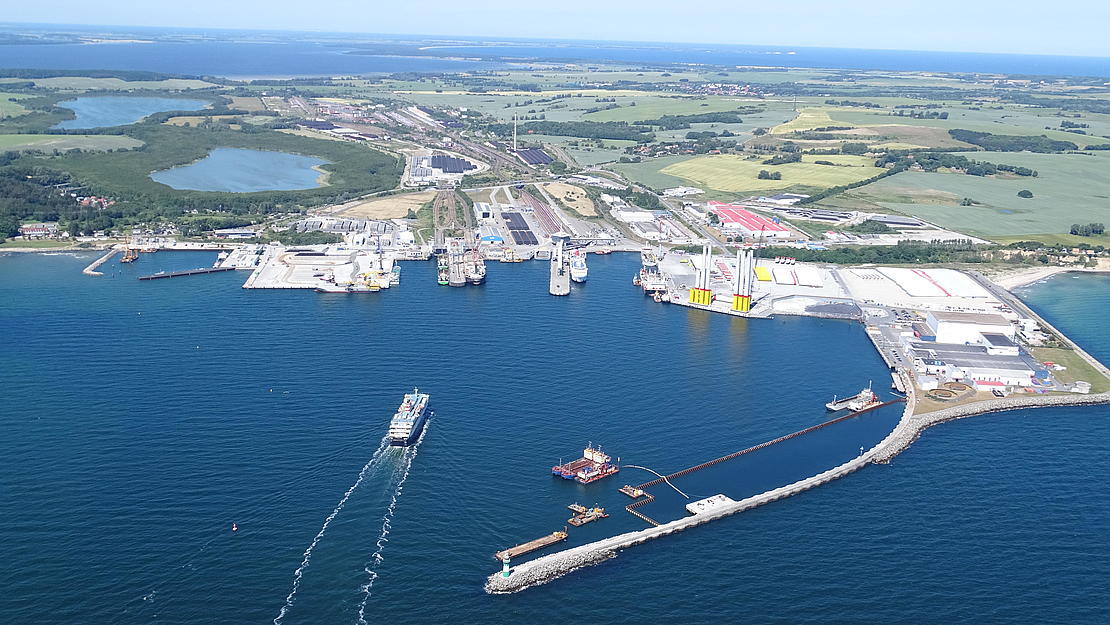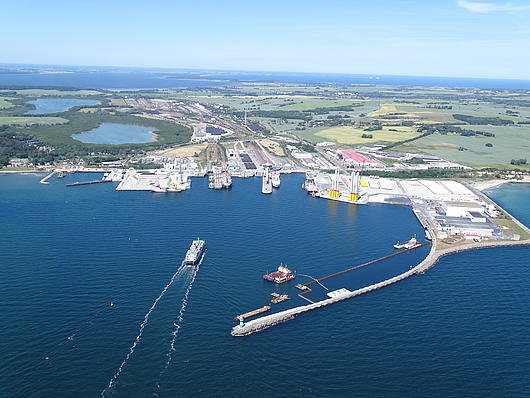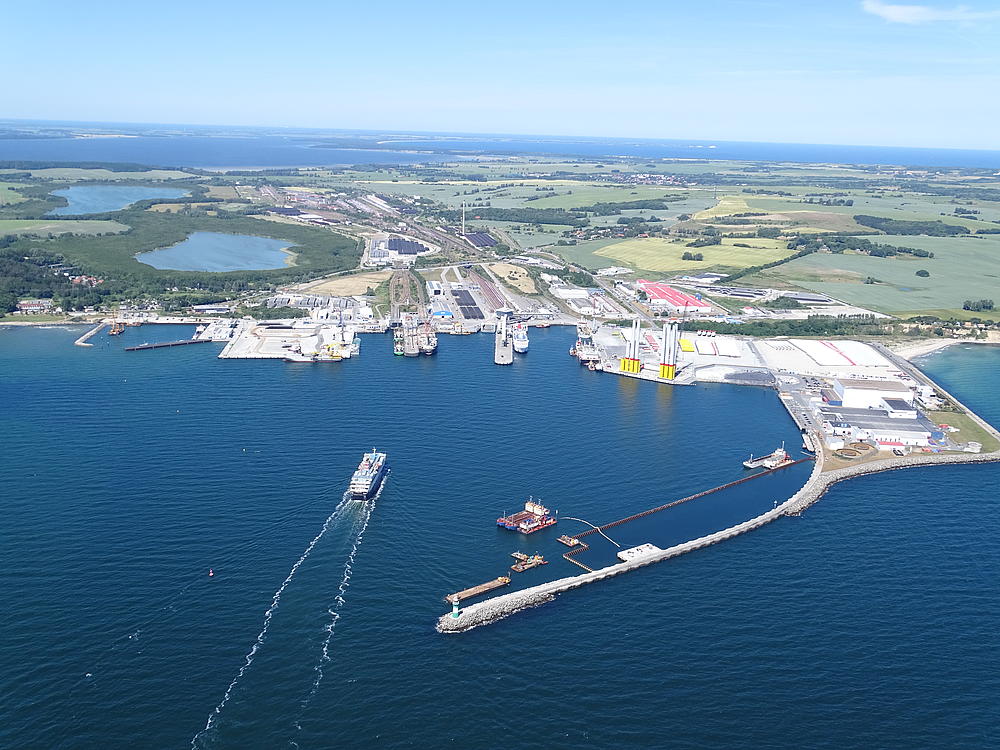06.06.2023
Mobile spherical hydrogen storage in TransHyDE
- After restructuring, the joint project is now starting with a new focus.
- The storage and transport of gaseous hydrogen will be investigated in order to supply consumers who are not connected to an H2 pipeline network.
- In the project, spherical storage vessels are being developed that are characterised by an optimal compromise between load- and material-appropriate geometry as well as low manufacturing and operating costs and thus enable efficient transport with a high payload ratio.
In the TransHyDE project Mukran, six partner organisations from industry and academia develop new spherical storage systems for hydrogen. The project is part of the hydrogen flagship projects funded by the Federal Ministry of Education and Research (BMBF).

Sassnitz/Essen/Hamburg/Cottbus/Wildau – How can volatile hydrogen molecules be stored and transported on ships, rails and roads? This question is being addressed by six partner companies under the leadership of the Gas- und Wärme-Institut Essen (GWI) in the TransHyDE project Mukran. The consortium investigates and develops new types of containers in the field of high-pressure hydrogen storage and decentralised, trimodal hydrogen distribution – in other words, the hydrogen container should be able to be transported by lorry, ship and train. This enables a decentralised supply to consumers far away from the pipeline network, emphasises Janina Senner, network coordinator of the TransHyDE project Mukran from GWI. “To secure the future supply situation, it is important to test further transport routes of gaseous hydrogen outside the pipeline network. The best way to do this in a decentralised way via a trimodal transportation concept using water, rail and road.”
The aim of the project is to implement and demonstrate the entire process chain from container development and prototype manufacture to a mobile storage unit suitable for road, rail and ship transport.
To this end, the project partners, the Fraunhofer Institute for Applied Polymer Research IAP Research Unit Polymer Materials and Composites PYCO and the Brandenburg University of Technology Cottbus-Senftenberg (BTU) Department of Polymer-Based Lightweight Construction, develop two spherical accumulator variants with different material compositions under the direction of Univ.-Prof. Dr.-Ing. Holger Seidlitz. In the first spherical storage vessel, a combination of a steel liner with an outer skin made of carbon fibre reinforced plastic (CFRP) is developed. In the second spherical storage vessel, two different steels are used. Here, high-strength alloys, new types of material-appropriate manufacturing processes as well as rule-based optimisation strategies are the innovation drivers and guarantee safety at high operating pressures despite minimised wall thicknesses. The partners expect decisive advantages from the choice of materials: on the one hand, cost savings that make the spherical storage vessels competitive, and on the other hand, a longer service life and improved recyclability.
In order to make the new types of hydrogen storage mobile, it is planned to install them in standardised container formats. To do this, however, a frame must first be developed that keeps the spherical storage units stable within the container during transportation. This is also the task of the two research organisations. In cooperation with the Sassnitz ferry port “Mukran Port” on the island of Rügen and the European logistics company Hamburger Hafen und Logistik AG (HHLA), they discuss the requirements for transport as well as the filling and removal of the hydrogen. These steps will then be tested in practice at HHLA's facilities in Hamburg and at Port Mukran. In order to also consider the results of the trimodal transportation of gaseous hydrogen throughout Germany, different transport options are examined in more detail in a model at GWI. The strategic project consultancy cruh21 is responsible for disseminating the results and finding suitable investors.
The entire project is funded with around 19 million Euros by the German Federal Ministry of Education and Research and is part of the lead project TransHyDE. The project partners are Gas- und Wärme-Institut Essen e.V. (GWI), Brandenburg University of Technology Cottbus - Senftenberg (BTU), Fraunhofer Institute for Applied Polymer Research (IAP), the port operator Mukran Port (Fährhafen Sassnitz GmbH), Hamburger Hafen und Logistik AG (HHLA) and the independent consultancy cruh21 GmbH.

Future-oriented work is important to the project team.
“The supply of hydrogen is an important building block for achieving the climate protection goals. In order to ensure a nationwide supply, it is important to distribute hydrogen in a decentralized manner within Germany. The GWI investigates which logistics and transportation options are possible and sensible for gaseous hydrogen as part of the project.” (Janina Senner, Team Leader PtX at the Gas- und Wärme-Institut Essen e.V.)
“Both to achieve climate protection goals and to expand the independence of the German energy market, the expansion of renewable energies and storage as green hydrogen is a basic prerequisite. To this end, the BTU's Department of Polymer-Based Lightweight Construction is develops two types of high-pressure tanks together with the project partners. The inherent masses of the tanks are reduced through novel manufacturing technologies, the optimisation of processes and the use of high-performance materials.” (Univ. Prof. Dr.-Ing. Holger Seidlitz, Head of the Department of Polymer-based Lightweight Construction and Acting Head of the Chair of Joining and Welding Technology at the BTU as well as Head of the PYCO research area at the Fraunhofer IAP)
“The hydrogen economy is a central building block in the transformation of the energy sector. High-pressure tanks are ideal for storing the gas with a low inherent energy content. As part of TransHyDE, spherical CFRP-reinforced tanks are being designed at the Fraunhofer IAP, the layer structure optimised and a monitoring system implemented. In this way, the Fraunhofer IAP and the project partners will provide industries with a safe storage solution with a high payload ratio.” (Prof. Dr. rer. nat. Christian Dreyer, Deputy Head of the PYCO Research Department at the Fraunhofer IAP and Head of the Chair of Fibre Composite Material Technologies at TH Wildau)
“With its participation in the TransHyDE Mukran project, HHLA pursues the goal of developing sustainable and economical solutions for the transportation of hydrogen. By optimising the process chain for storing and transporting gaseous hydrogen, the aim is to significantly reduce the supply costs of green hydrogen to enable value-added use.” (Dr Georg Böttner, Head of Hydrogen Projects at HHLA)
“Participation in the TransHyDE consortium enables research and industry to work together to drive the implementation process of new technologies forward in a targeted and time-effective manner. Only in this way can everyone make a contribution to climate protection and at the same time advance the economy in Germany.” (Claudia Martens, Marketing & Development Industries of the Sassnitz ferry port, Mukran Port)
“TransHyDE combines the strengths of research and industry for a sustainable decarbonisation of the German economy. cruh21 contributes its expertise in knowledge transfer and interface communication. My wish for the TransHyDE consortium is interdisciplinary cooperation as equals.” (Artur Flaum, Junior Consultant at cruh21)
About the hydrogen flagship projects
The hydrogen flagship projects are the largest research initiative of the German Federal Ministry of Education and Research on the subject of the energy transition to date. In the three flagship projects, industry and academia are jointly develop solutions for the German hydrogen economy: serial production of large-scale electrolysers (H2Giga), production of hydrogen at sea (H2Mare) and technologies for the transportation of hydrogen (TransHyDE).
The flagship project TransHyDE develops, evaluates and tests hydrogen transport solutions. A hydrogen economy cannot function without a suitable transport infrastructure, so four transport technologies are to be advanced in demonstration projects: (1) hydrogen transportation in high-pressure containers, (2) hydrogen-liquid transportation, (3) hydrogen transportation in existing and new gas pipelines, and (4) transportation of hydrogen bound in ammonia or the carrier medium LOHC.
More information at https://www.wasserstoff-leitprojekte.de/projects/transhyde

Download image

Mobile spherical hydrogen storage in TransHyDE
